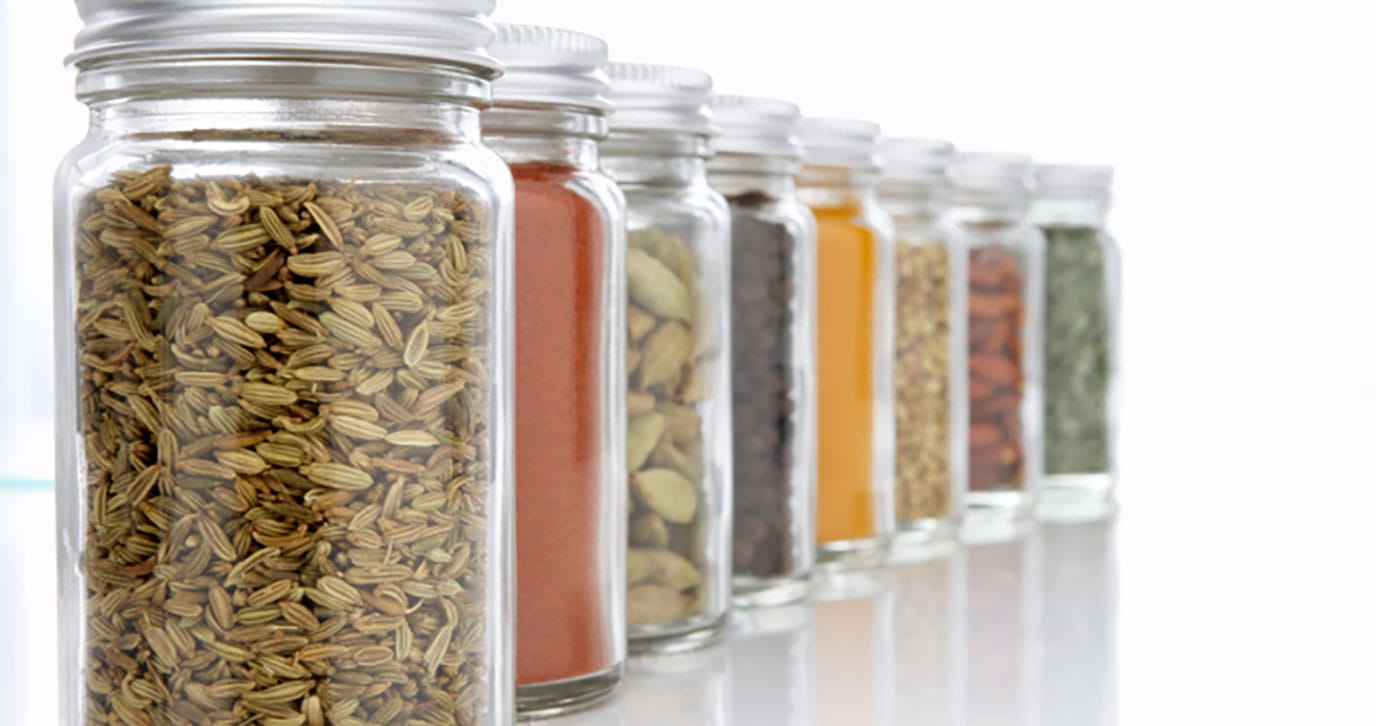The Dietary Guidelines for Americans (DGA) focuses on helping consumers achieve a healthy weight, consume nutrient-dense foods and beverages, and address modifiable health factors such as the number of calories they consume, the number of calories they expend in physical activity, and their food and activity environment. Promising research is beginning to emerge that suggests spices and herbs can support the DGA by making recommended foods and healthy eating patterns more acceptable to consumers and/or through their beneficial physiological effects, such as enhanced satiety or improved biochemical risk factors. Examples of these contributions to 3 major areas of the 2010 DGA include the following:
1. FOODS AND NUTRIENTS TO INCREASE
Consumers are advised to increase their fruit and vegetable intake and also eat a variety of vegetables, especially dark-green, and red and orange vegetables, and beans and peas. Spices and herbs may help increase the acceptance of these nutrient-dense foods by making them more palatable. For example, preschool children ate more of a disliked vegetable (celery or steamed squash) when it was paired with an herb dip than when it was eaten alone.
2. FOODS AND FOOD COMPONENTS TO REDUCE
The DGA advises consumers to consume several foods and food components less often, including sodium and saturated fat. Recent research suggests that spices and herbs may help consumers adhere to lower-sodium eating plans and reduced-fat foods and meals (see pages S8–S9 and S12–S13).
Sodium Intake. Consumers are advised to reduce their daily sodium intake to less than 2300 mg and further reduce their intake to 1500 mg if they are 51 years or older or if they are African American or have high blood pressure, diabetes, or chronic kidney disease, regardless of their age. Spices and herbs have the potential to improve adherence to recommended lower-sodium intakes, increase the long-term liking of lower-sodium foods, and enhance adherence to reduced-sodium eating patterns. For example, in 1 study,healthy adults were provided all foods, snacks, and beverages that complied with a low-sodium (<1500 mg/d) diet for 4 weeks, after which they were randomized to either a behavioral intervention that emphasized spices and herbs or a self-directed control group that received educational materials on reducing sodium intake. At the end of the 20-week behavioral intervention, 24-hour urinary sodium excretion (a measure of compliance with a low-sodium diet) increased in both groups but was significantly lower (P = .002) in the behavioral intervention group compared with the self-directed control group. The findings suggest that emphasizing spices and herbs made lower-sodium foods more flavorful and facilitated adherence to a low-sodium diet.
Saturated Fat Intake. The DGA advises consumers to reduce their intake of saturated fatty acids to no more than 10% of calories. The study described in the article by Hill (see page S12) showed that adding spices and herbs to certain reduced-fat foods restored the “liking” ratings to those of the full-fat versions. Thus, spices and herbs have the potential to help consumers meet the DGA guidelines for saturated fat without sacrificing taste.
3. BALANCE CALORIES TO MANAGE WEIGHT
The DGA advises consumers to prevent and/or reduce overweight and obesity through improved eating and physical activity behaviors. Dietary behaviors required to achieve this goal typically involve reducing total calorie intake, eating smaller portions, and reducing the intake of high-fat foods. Recent studies have shown that culinary amounts of red pepper (Capsicum annuum L. var annuum, Solanaceae), which contains capsaicin and related compounds (together called capsaicinoids), increased satiety and energy expenditure in healthy people. In clinical trials, capsaicinoid doses ranged from 0.4 to 30 mg consumed during 1 to 10 meals or 2.25 to 33 mg consumed daily over 4 to 6 weeks; a minimum dose of 2 mg of capsaicinoids (found in roughly 0.8 g or ½ tsp of red pepper) is needed to reduce energy intake. These findings suggest red pepper may be useful as part of a weight management program (see page S6). A separate study found that daily consumption of ginger (Zingiber officinale Roscoe, Zingiberaceae) reduced muscle pain caused by eccentric exercise in young, healthy volunteers, which might make it easier to adhere to daily physical activity.
PHYSIOLOGICAL BENEFITS OF SPICES AND HERBS
A major purpose of the DGA is to help consumers stay healthy by reducing their risk of chronic diseases, such as cardiovascular disease and diabetes. Research is accumulating that suggests the physiological effects of some spices and herbs may support the DGA in this area. For example, a spice blend added to a high-fat meal decreased postprandial insulin (P = .004) and triglyceride (P = .048) concentrations compared with the same meal without added spices among healthy subjects (see page S8) and a grilled hamburger patty containing added spices and herbs improved biomarkers of postprandial endothelial function (P < .05) compared with a plain burger among patients with type 2 diabetes mellitus (see page S4). In addition, considerable evidence suggests that cinnamon (Cinnamomum verum J. Presl, Lauraceae) may have favorable effects on glucose homeostasis (see page S10). These studies suggest that spices and herbs have the potential to support the DGA not only by making healthier foods and dietary patterns more acceptable to consumers, but also by exerting beneficial physiological effects.
OPPORTUNITIES FOR THE 2015 DGA
A basic premise of the DGA is that nutrient needs are met through consuming foods. The challenge going forward is to identify research, education, and policy opportunities that will help Americans follow current dietary guidelines (Table). Studies might be designed to develop reference amounts (ie, recommended servings) and determine nutrient standards for spices and herbs and their bioactive components as part of foods.
CONCLUSIONS
The DGA establishes the model of a healthy eating pattern for Americans 2 years or older and is used as the basis of all federal food and nutrition programs, which then apply its recommendations in the development of nutrition standards for dozens of programs, nutrition education curriculum materials, and communications programs such as MyPlate and the ChooseMyPlate.gov resources. With the development of the 2015 DGA, there is an opportunity to inform Americans about healthy eating patterns and encourage them to substitute spices and herbs for sodium, fat, and sugar in home-cooked dishes. Research data suggest that spices and herbs may exert physiological benefits important to human health and make foods more acceptable by enhancing flavor.















